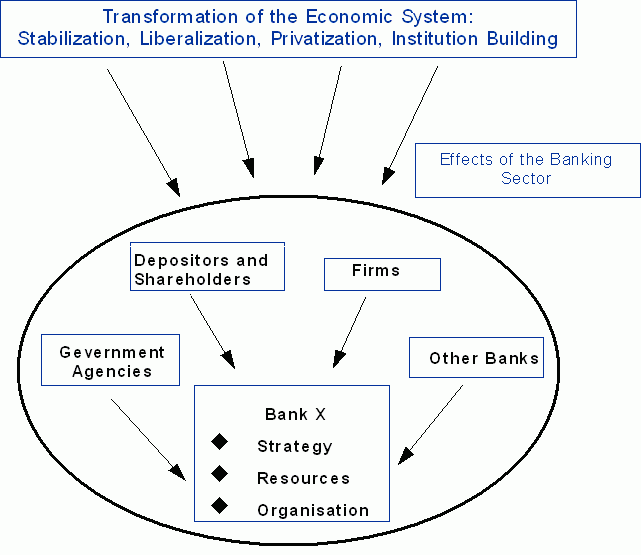Banking in the CIS: An Analytical Overview for Westerners
Category: Bank Management
This part of the handbook provides some background for Western bankers and consultants who may not always be acquainted with the specificities of banking in the CIS. Figure 1 presents our approach to the understanding of banking in transition.
Figure 1: CIS banks and their environment in transition
Banks in the CIS are subject to a highly dynamic environment. Two kinds of factors influence in a direct or indirect way the business of banks:
The transformation of formerly Centrally Planned Economies (CPE’s) into market economies via stabilization, liberalization and privatization policies, and institution building affects the rules according to which the banking sector of a given country operates. Besides this indirect effect, banks have to cope with high uncertainty due to effects of economic transformation such as highly volatile inflation and interest rates, sectoral shocks and political instability.
Within the banking sector there are a number of organizations and individual economic actors that are relevant for a bank: first, government agencies like the central bank, regulatory institutions or branch ministries; second, depositors and shareholders; third, firms, i.e. state-owned enterprises (SOE’s) privatized and newly funded private SME’s (small and medium-sized enterprises); and fourth, competitors (both domestic and foreign).
In order to survive, banks must find an optimal response to their environment. We analyse this reponse along three dimensions: strategy, use of resources and organization. Each single bank has to take the systemic changes and the market organization of the banking sector as given, and adapts to its environment. However, the outcome of this process and the activities of the banking sector as a whole are decisive for the success of transition towards a market economy.
In accordance to Figure 1, we analyse the effects on transition on banking in the CIS by descending order of magnitude: First, transition, the macroeconomic process of transformation of an economy from a CPE to a market economy, is briefly described and the main shortcomings of this process in the CIS are identified (section 2.1). Second, we give an overview of sectoral developments of the banking sector in the CIS (2.2), and present some scenarios for future developments (2.3). We then analyse the response of banks in transition countries along strategy, use of resources and organization (2.4). Finally, we discuss some important aspects of human resources management that appears to be of specific importance for CIS banks.

